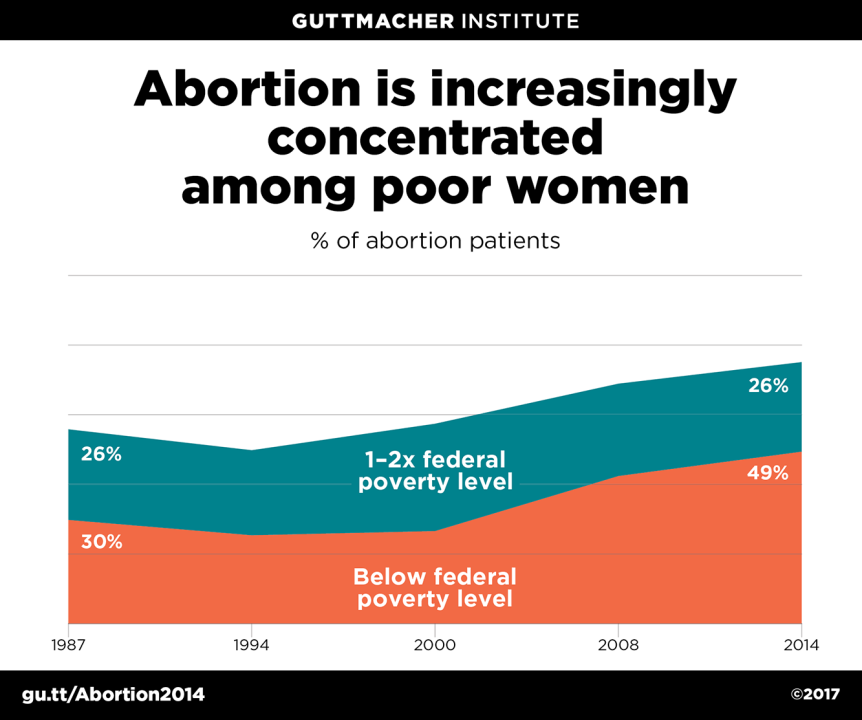Nearly one in four women in the United States (23.7%) will have an abortion by age 45, according to a new analysis by Guttmacher Institute researchers Rachel Jones and Jenna Jerman, just published in the American Journal of Public Health. By age 20, 4.6% of women will have had an abortion, and 19% will have done so by age 30.
"Despite recent declines in abortion, it is still a common procedure, and nearly one in four U.S. women will have an abortion in her lifetime," says Rachel Jones, lead author of the analysis.
Between 2008 and 2014, the overall U.S. abortion rate declined by 25%, from 19.4 to 14.6 abortions per 1,000 women aged 15–44. Key data points that may help explain this decline, including trends in unintended pregnancy, are not yet available for this time period. However, the available information suggests that improvements in contraceptive use—particularly among women aged 20–24, who account for one-third of unintended pregnancies in the United States—were an important driver behind the decline. Abortion rates declined among all demographic groups from 2008–2014, but the declines varied widely by group.
For the first time in two decades, the abortion rate declined among women whose family income was less than 100% of the federal poverty level ($19,790 for a family of three in 2014). However, the abortion rate among poor women remains the highest of all groups examined in the study, at 36.6 abortions per 1,000 women of reproductive age. Abortion has become increasingly concentrated among poor women, who accounted for 49% of patients in 2014.
In the same year, women aged 20–24 accounted for the largest proportion of abortions (34%) and had the highest abortion rate (28 per 1,000 women in this age-group) among all age-groups studied. Women aged 25–29 had the second highest rate at 22.8 per 1,000. In 2014, adolescents aged 15–19 accounted for just 12% of all abortions. The abortion rate among adolescents declined 46% between 2008 and 2014, the steepest decline of any demographic group over this period.
Abortion rates continue to vary widely by race and ethnicity as well. Among the four groups examined in the study, black women had the highest abortion rate in 2014 (27.1 abortions per 1,000 women of reproductive age) and white women had the lowest rate (10 per 1,000). Between 2008 and 2014, women of color experienced the steepest abortion rate declines: Rates fell 32%–39% among Hispanic and black women and those who identified with a race other than black or white, compared with a 14% decline among white women. Differences in abortion rates by race and ethnicity are likely due to a combination of factors that stem from a long history of racism and discrimination, as well as lack of access to high-quality, affordable health insurance and care.
"Learning more about differences in abortion rates could inform strategies to reduce disparities in reproductive health care," says Jones. "The more we know about those having abortions, the better enabled we will be to meet their reproductive health needs."
State and federal policy changes also may have played a role in the most recent abortion rate declines. The wave of state abortion restrictions enacted since 2011 could have made abortion more difficult to access, especially for poor women, women of color and those who live in states with particularly restrictive abortion laws. On the other hand, the Affordable Care Act’s Medicaid expansion may have improved access to abortion in some parts of the country. In states that already used their own funds to cover abortion for Medicaid enrollees and then expanded Medicaid eligibility to more residents, some women who otherwise could not afford the cost of an abortion may have been able to obtain one.
"Supportive policies like Medicaid coverage can make it easier for women to access needed abortions, while restrictive policies often do exactly the opposite," says Heather Boonstra, Guttmacher policy expert. "All women, regardless of age, income or race, should be able to obtain reproductive health services, including abortion, free from political and economic barriers."
"Population Group Abortion Rates and Lifetime Incidence of Abortion: United States, 2008–2014," by Rachel Jones and Jenna Jerman, is currently available online and will appear in a forthcoming issue of the American Journal of Public Health.

